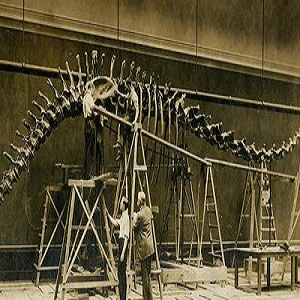Doctor Curmudgeon Gone But Not Forgotten
By Diane Batshaw Eisman, M.D. FAAP Doctor Eisman is in Family Practice in Aventura, Florida with her partner, Dr. Eugene Eisman, an internist/cardiologist
We can still find their foot prints.
Africa and South America had previously been joined together. The continents began drifting apart around 140 million year ago. That’s why paleontologists have spotted Dinosaur footprints in Cameroon and in Brazil—two countries separated by over 3500 miles of ocean.
Dinosaurs!
I have been in awe of dinosaurs since childhood–when I lurked in the corridors (under parental control, of course) of the Chicago History Museum.
And so, I was delighted to learn that scientists have found their fossilized footprints. Most of the footprints were from dinosaurs that had three toes with claws on every limb and hollow bones.
As I gaze at the small plastic dinosaur atop my computer—I muse about why they are no longer with us.
We may now have answers.
Over the years, there has been a lot of speculation that a bunch of huge asteroids slammed into the earth. Just theories. And then in 1953 two geologists, Allan O. Kelly and Frank Dachille were able to analyze geological evidence strongly suggesting that wayward asteroids had impacted onto our planet. This tremendous impact would have caused an equally tremendous shift of our axis. And it would have resulted in firestorms, great floods, volcanic eruptions, and cyclones. No way dinosaurs would have survived.
Then, in 1980, we could at last put the question of dinosaur extinction to rest. Nobel prize-winning physicist Luis Alvarez and his geologist son, Walter Alvarez led a team studying the mass extinction of dinosaurs. Their team studied sedimentary layers for the K-T boundary, which is the geological marker of the end of the Cretaceous Period and the beginning of the Tertiary Period. They found asteroid dust in the same geological layer corresponding to the time of the dinosaur extinction.
More evidence—a crater was discovered in the Gulf of Mexico that correlated with that same time. Jake Parks writes in the Astronomy Newsletter, “And because the crater appeared to be the same age as the global rock layer enriched with asteroid dust, researchers were fairly certain they had the story of the dinosaurs’ demise figured out”.
Over at the Berkeley Geochronology Center, Paul Renne reported that the asteroid impact occurred around 66,038,000 years ago. And the poor dinosaurs were annihilated within about 33,000 years of that date.
The Asteroid Theory is known now as the Alvarez Asteroid theory.
Andrea Gawrylewski, the chief newsletter editor in the Scientific American writes that “It was definitely an asteroid…researchers measured levels of ruthenium isotopes at three different sites around the globe, as well as from meteorites, other craters from different impacts and multibillion-year-old rocks. They determined that the ruthenium is certainly extraterrestrial in origin and most likely came from a carbonaceous asteroid, which was rich in carbon and organic compounds and must have formed in the outer solar system”.
Since our ancient human ancestors did live with dinosaurs, I wonder how Dino the Flintstones pet dinosaur fared. Somewhere there must be a research project delving into this.
THE PHOTO IS FROM SEARCH BRITANNICA ONLINE
Dr. Curmudgeon suggests “Bitter Medicine”, Dr. Eugene Eisman’s story of his experiences–from the humorous to the intense—as a young army doctor serving in the Vietnam War.
Bitter Medicine by Eugene H. Eisman, M.D. –on Amazon
Doctor Curmudgeon® is Diane Batshaw Eisman, M.D., a physician-satirist. This column originally appeared on SERMO, the leading global social network for doctors.
SERMO www.sermo.com
Click Here to Order Boxing Interviews Of A Lifetime By “Bad” Brad Berkwitt


